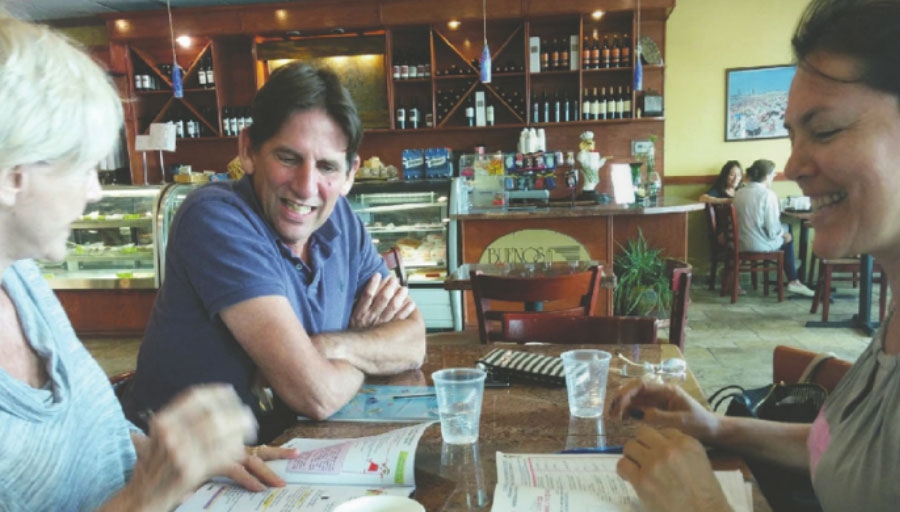by Catalina Valenzuela on /07/02/2014 at 03:53am
Translation by Suzi Rudd Cohen
Liliana Zambrano, a Spanish teacher and author, for the 21st century, says, “ Thirteen years ago, I came from Pasto, Colombia, to Miami, holding the hand of my partner, looking for new horizons, and we have not looked back”.
As soon as she was settled, the first thing she did was learn English. For nine months, enrolled in a formal adult class at Miami Dade College, she devoted herself exclusively, to study and learn how the English language works. Liliana thought that speaking and understanding English was a fundamental goal to accomplish.
Her dedication and devotion, to these classes, drew the attention of one of her teachers who recommended her for a position as a Spanish teacher at a small Miami Beach academy. She jumped right in, making it clear from the beginning, that she was not an expert Spanish teacher.
Liliana told me that her greatest frustrations and challenges, as a teacher, included listening to students who said, “I am too old to learn” and working to retain her student base. In response to these challenges, she has become a “professora” dedicated to understanding her mostly adult students as they progressed in the process of learning a new language. Her students span many ages and life stages. Some of them live year round in Miami and others are here just for the winter. The roster includes young working adults and many retired older adults who want to keep their minds sharp. Her first hand experience, as an adult learning English, allowed her to more easily tackle the difficulties facing her students.
“What was the most difficult moment in your career”? She replied without hesitation, “it was, in the beginning, when the students did not remain engaged in the learning process”. And so, she began the task of analyzing the failures in her method so, that she could improve her teaching technique. Her ongoing process of reflection in her professional practice, her ability to create connections with her students helps them to improve, learn and continue to study and, as a result, her students remain with her as they strengthen their Spanish language skills.
If anything defines Liliana, it is her ability and willingness to research and the discipline to find answers. These two qualities led her to design her own teaching method. Her approach focuses on speaking Spanish, right from the initial class, which she asserts, “is quite motivating”. Liliana believes that her method is fun, clear and easy to follow. She has published two “Dive into Spanish” books that aim to guide her students as they acquire a more natural Spanish from the early stages of learning. Her third book, “Simple Latin American Spanish Phrases About Love and Other Things”, is aimed at people who do not speak Spanish but want a reference for useful key phrases. The books are available at “Books and Books” and Amazon.
She had not thought about being an educator until her journey brought her to Miami. She is grateful for her hometown education and her tenacious approach to learning. “I majored in Spanish grammar; researching and studying a little every day; they are the same questions and doubts that my students have to tackle.”
However, as disciplined as Liliana is, she does not have a strict daily routine for her classes. Everyday is different; sometimes, the lesson takes place at the student’s home, or in an art deco house, a cafe with a Latin flavor or a traditional classroom. As a way to introduce the Latin culture, she wants each student to consider Miami as the “capital city” of Central and South America. Here, for example, we can learn that Colombians refer to a “papaya”, the Venezuelans call it “lechosa” and the Cubans say, “fruta bomba”. She believes that learning Spanish in Miami is like taking an adventure tour through many countries.
Liliana admits that teaching is both her career and her hobby. “It is my job because I receive compensation, fulfill a contract and set a schedule. But, it is my life’s passion because we, the students and I, have so much fun while we are learning”. She knows, based upon the fact that her students return, week after week, to take lessons, that her patience and technique has resulted in student retention. “My method motivates my students to learn and to feel that speaking Spanish is possible. We establish a strong bond of friendship, based on respect and tolerance, and, of course, affection. We (my students and I), create a space where both parties learn. There is no competition, no sense of superiority; just equality as both of us are involved in the process of teaching and learning.” She is able to strengthen the intellectual, emotional and psychological development of her students. “Together, we discover and customize the most effective method to study Spanish.” Many scholars support this manner of education for the 21st century in both formal and informal models. It is a space to “co-create” or to put it another way, “to create together.”
At the conclusion of the interview, I asked her to share some tips for Hispanic entrepreneurial women. Here are the thoughts of this dynamic “professora” and author:
- Have an in-depth knowledge about your product and service. Research your target customer and learn about the competition.
- Create one or more distinctive features to make your product recognizable in the market to contrast with the competition.
- Prepare a plan to establish the business philosophy, goals, financial goals and a marketing plan to reach the customer.
- Establish close ties with customers and clients that reaffirm your relationship based on honesty, respect and trust to build loyalty and result in good reviews to attract new customers.
- Listen to clients, analyze their suggestions and complaints as an opportunity to improve the service or product and to stand apart from the competition.






